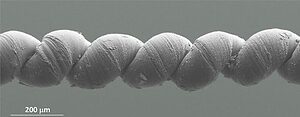Scientists at University of Texas Dallas have made artificial muscles capable of supporting 100,000 times their own weight and generate 85 times more mechanical power than natural muscle of the same size. Applications for this kind of technology are quite numerous, ranging from extremely strong and intelligent textiles to high-temperature applications since the fabric has a negative thermal expansion coefficient.
The artificial muscles were constructed from carbon nanotubes, tiny hallow cylinders made from the same made from the same type of graphite layers found in the core of ordinary pencils. The nanotubes were put together as to constitute a string of yarn. The yarn was infiltrated with simple paraffin wax, commonly found in candles, and then twisted. Because the wax is a “volume changer”, when the composite twisted yarn was heated either electrically or using a flash of light the wax expanded. As such the yarn volume increased, and the yarn length contracted.
“The artificial muscles that we’ve developed can provide large, ultrafast contractions to lift weights that are 200 times heavier than possible for a natural muscle of the same size,” said Dr. Ray Baughman, team leader, Robert A. Welch Professor of Chemistry and director of the Alan G. MacDiarmid NanoTech Institute at UT Dallas. “While we are excited about near-term applications possibilities, these artificial muscles are presently unsuitable for directly replacing muscles in the human body.”
Smart fabric made out of nanotech yarn
Muscle contraction – also called actuation – can be ultrafast, occurring in 25-thousandths of a second. Including times for both actuation and reversal of actuation, the researchers demonstrated a contractile power density of 4.2 kW/kg, which is four times the power-to-weight ratio of common internal combustion engines.
“Because of their simplicity and high performance, these yarn muscles could be used for such diverse applications as robots, catheters for minimally invasive surgery, micromotors, mixers for microfluidic circuits, tuneable optical systems, microvalves, positioners and even toys,” said Baughman.
For instance, because of their ultra-fast expansion/contraction to slight temperature changes, the artificial muscles could be employed in smart clothing whose textile porosity could change in order to provide thermal or chemical comfort. The yarn can be easily twisted together, woven, sewn, braided and knotted.
Also the yarn has been found to contract only by 7% when lifting heavy loads at a whooping 2,500 degrees Celsius – that’s 1000 degrees past the melting point of steel, where no other high-work-capacity actuator has been able to survive.
“The remarkable performance of our yarn muscle and our present ability to fabricate kilometer-length yarns suggest the feasibility of early commercialization as small actuators comprising centimeter-scale yarn length,” Baughman said. “The more difficult challenge is in upscaling our single-yarn actuators to large actuators in which hundreds or thousands of individual yarn muscles operate in parallel.”
The findings were reported in the journal Science,










